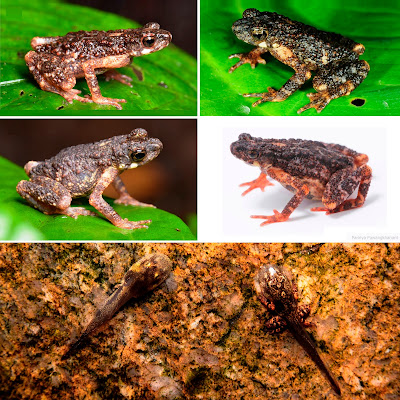 |
| Ansonia karen Suwannapoom, Grismer, Pawangkhanant, Naiduangchan, Yushchenko, Arkhipov, Wilkinson & Poyarkov, 2021 คางคกห้วยกะเหรี่ยง | Karen Stream Toad || DOI: 10.3897/vz.71.e73529 Photos by N. A. Poyarkov & M. Naiduangchan. |
Abstract
The integrated results of morphological and molecular phylogenetic analyses confirmed the new species status of a recently discovered population of Ansonia from Suan Phueng District, Ratchaburi Province, Thailand. Ansonia karen sp. nov. is separated from all other species of Ansonia by a unique combination of mensural, discrete morphological, and color pattern characteristics and is the sister species of A. thinthinae from Tanintharyi Division, Myanmar. This discovery fills a geographic hiatus of 350 km between it and A. kraensis from Ranong Province, Thailand. Ansonia karen sp. nov. is the newest member of a long list of range-restricted endemics having been recently discovered in the northern Tenasserim Mountain region of western Thailand and continues to underscore the unexplored nature of this region and its need for conservation.
Key words: Ansonia karen sp. nov., Molecular phylogenetics, Ratchaburi Province, Southeast Asia, Tenasserim Mountains, Thai-Malay Peninsula, toads
 |
| Holotype of Ansonia karen sp. nov. (ZMMU A-7605) from Suan Phueng District, Ratchaburi Province, western Thailand. Photo by N. A. Poyarkov. |
Ansonia karen sp. nov.
Suggested Common Name: Karen Stream Toad
Diagnosis: Ansonia karen sp. nov. is recognized as a member of the genus Ansonia based on the results of the molecular phylogenetic analyses that recover it as the sister species of A. thinthinae (Fig. 2) as well as by a combination of the following morphological characters: small body size (maximum SVL 25.6 mm in males and 29.2 mm in females); long slender limbs bearing long slender digits with bulbous tips; absence of parotoid glands; weak subarticular tubercles; and membranous foot webbing (Inger 1960, 1966, 1992; Wilkinson et al. 2012; Chan et al. 2014; Grismer et al. 2016; Quah et al. 2019). It can be differentiated from all congeners by the following combination of characters: maximum SVL in males 25.4 mm and females 29.2 mm; snout projecting beyond lower jaw; tympanum visible; no interorbital or tarsal ridges; first finger shorter than second; finger tips bulbous, toe tips slightly dilated forming weak discs; approximately 2.5 phalanges free of web on fourth toe and 0.5 phalanges free of web on fifth toe; yellow rictal tubercles at angle of jaw; distinct, red-tipped, spiny tubercles on dorsum and flanks; abdomen coarsely granular; no oblique flaps of skin bordering vent; wide, light-colored patch below eye; light-colored, generally diamond-shaped interscapular spot; large, discrete, yellow, submandibular spots; no light-colored streaks on canthus rostralis; dorsum black, lacking an X-shaped marking surrounding interscapular spot; no dark-colored markings on rump; no dark dorsolateral stripe; iris yellow-gold; fore- and hind limbs bearing irregularly shaped, light-colored crossbars; venter and undersides of limbs dull-yellow bearing thick, grey-brown reticulations; palmar surfaces of hands and thenar surfaces of feet reddish-orange in life.
 |
| Distribution of the species of the Thai-Burmese clade of Ansonia. |
Distribution: Ansonia karen sp. nov. is currently known only from the type locality and nearby locality in same forest stream in the environs of Khao Laem Mountain, in Suan Phueng District of Ratchaburi Province in western Thailand, less than 2.0 km from the international Thai–Myanmar border (Fig. 1). The new species likely inhabits the middle portion of the Northern Tenasserim Mountain range (between the Kanchanaburi and Prachuap Khiri Khan provinces), and is expected to occur in adjacent montane areas in the western part of Phetchaburi Province of Thailand and Thanintharyi Division of Myanmar.
 |
| Natural history of Ansonia karen sp. nov. A. Breeding habitat in Suan Phueng District, Ratchaburi Province, western Thailand. Photo by M. Naiduangchan. |
Natural history:
The new species inhabits a polydominant montane tropical evergreen forest on Khao Laem Mountain at elevations from ca. 700 to 750 m a.s.l., where the adult specimens were observed at night perched on leaves or stones (Fig. 7B–C) along an approximately 1–3 m wide, slow-flowing mountain stream (Fig. 7A), or beneath stones along the stream’s edge. The multi-species polydominant tropical forest at the type locality has dense vegetation with tangles of giant bamboo Dendrocalamus asper (Schult.) Backer. Males were calling during our field observations from June to November throughout 2017–2019. The tadpoles of the new species were recorded in the same stream and were usually concentrated in pools under small waterfalls, hiding under gravel on the stream bottom, or sitting on the vertical surfaces of large submerged boulders to which they were attached by their oral discs (Fig. 7D).
The species of amphibians and reptiles recorded in sympatry with the new species at the type locality include: Leptobrachium tenasserimense Pawangkhanant, Poyarkov, Duong, Naiduangchan & Suwannapoom, L. smithi Matsui, Xenophrys cf. major (Boulenger), Leptobrachella melanoleuca (Matsui), L. fuliginosa (Matsui), Amolops panhai Matsui & Nabhitabhata, Alcalus tasanae (Smith), Limnonectes jarujini Matsui, Panha, Khonsue & Kuraishi, L. doriae (Boulenger), L. macrognathus (Boulenger), M. berdmorei (Blyth), Acanthosaura crucigera Boulenger, Pseudoxenodon macrops (Blyth), Trimeresurus popeiorum Smith, and Rhabdophis chrysargos (Schlegel).
Etymology: The specific name “karen” is given as a noun in apposition and refers to the name of the Karen people. Originally inhabiting wide areas in southern and southeastern Myanmar, many Karen have migrated to Thailand, having settled mostly on the Thailand–Myanmar border, including the Suan Phueng District, the type locality of the new species, due to the political turmoil during the end of XX – beginning of XXI centuries. We received significant help and assistance from the local Karen community in Suan Phueng during our field surveys and want to thank them for their permanent support. Nikolay A. Poyarkov also thanks Karen Sarkisian for his support and encouragement.
Chatmongkon Suwannapoom, L. Lee Grismer, Parinya Pawangkhanant, Mali Naiduangchan, Platon V. Yushchenko, Dmitriy V. Arkhipov, Jeffery A. Wilkinson and Nikolay A. Poyarkov. 2021. Hidden Tribe: A New Species of Stream Toad of the Genus Ansonia Stoliczka, 1870 (Anura: Bufonidae) from the poorly explored Mountainous Borderlands of western Thailand. Vertebrate Zoology. 71: 763-779. DOI: 10.3897/vz.71.e73529


